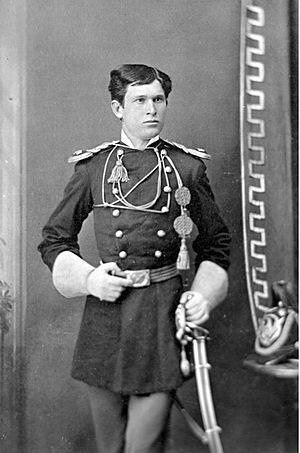Luther Hare facts for kids
Quick facts for kids
Luther Rector Hare
|
|
|---|---|

Luther R. Hare
|
|
| Born | August 24, 1851 Greencastle, Indiana |
| Died | December 22, 1929 (aged 78) Washington, D.C. |
| Place of Burial | |
| Allegiance | United States of America |
| Service/ |
United States Army and United States Volunteers |
| Years of service | 1874–1905, 1908–1911, 1918–1919 |
| Rank | |
| Unit | 7th U.S. Cavalry |
| Battles/wars | American Indian Wars
Spanish–American War
|
Luther Rector Hare (born August 24, 1851 – died December 22, 1929) was an important officer in the U.S. Army. He is best known for his role in the Battle of the Little Bighorn, a famous battle in American history. Hare served in the 7th Cavalry Regiment, a well-known military unit.
Contents
Early Life and Military Start
Luther Hare was born in Greencastle, Indiana, in 1851. His family moved to Texas when he was just two years old. When he was older, he decided to join the military.
In 1870, he entered West Point, which is a very famous military academy. He worked hard and graduated on June 17, 1874. Soon after, he joined the 7th U.S. Cavalry. By the time of the Great Sioux War of 1876, he was a second lieutenant, which is a junior officer rank.
Role in the Little Bighorn Battle
In June 1876, Lieutenant Hare was part of a major military expedition near the Little Bighorn River. He was helping with the Native American scouts, who were important for finding out what was happening.
During a difficult part of the battle, when many soldiers were under attack, Lieutenant Hare became an assistant to Major Marcus Reno. He helped Major Reno lead the troops during the intense fighting. Later, in 1879, Hare shared his experiences and what he saw during the battle at an official investigation.
Other Conflicts and Service
Luther Hare's military career included several other important conflicts. He took part in the Nez Perce War in 1877. This was another conflict between the U.S. Army and Native American tribes.
He also served in the Spanish–American War, which took place in the Philippines. After that, he was involved in the Philippine–American War. During this war, he played a role in helping to rescue U.S. forces who had been captured after the Battle of Pulang Lupa.
Hare retired from the military in July 1903 due to health reasons. However, he returned to active duty several times after that. He finally retired for good in February 1919, after many years of service.
Later Life and Burial
Luther Hare passed away on December 22, 1929, at Walter Reed Hospital in Washington, D.C.. He was buried at Arlington National Cemetery in Arlington County, Virginia, a special place where many American heroes are laid to rest.

